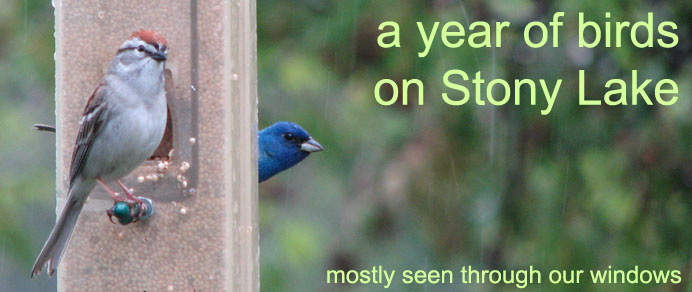 Courtesy of Lana Hays
Courtesy of Lana HaysWe were delighted to find at least two Cerulean Warblers (Dendroica cerulea) singing in the hardwood forest less than a kilometre from our back door. I recorded some sounds from the first bird we found singing on May 21, 2007. On May 23, we found two males countersinging 300 m from where we made our May 21 observation. The video begins and ends with a Cerulean song. There's some Red-eyed Vireo (Vireo olivaceus) chatter in between.
This follows our observation of a single Cerulean Warbler in the same woodlot in May last year. We don't know whether they're actually breeding but the habitat - mature, mesic upland hardwood forest - corresponds to that utilized by well-studied breeding populations at the Queen's University Biological Station, 200 km to the east. We'll monitor the site over the next few weeks for signs of breeding.
 The Cerulean Warbler is a species of special concern* in Canada, where the population is estimated to be only 500-1000 breeding pairs. Some populations in the United States have experienced precipitous declines. One of the threats to the Cerulean Warbler is the destruction of the tropical forests in which it, and a suite of other Neotropical migrant songbirds, spend the winter. This is one of the reasons we choose to buy shade grown coffee [on-line] from Birds and Beans in Toronto.
The Cerulean Warbler is a species of special concern* in Canada, where the population is estimated to be only 500-1000 breeding pairs. Some populations in the United States have experienced precipitous declines. One of the threats to the Cerulean Warbler is the destruction of the tropical forests in which it, and a suite of other Neotropical migrant songbirds, spend the winter. This is one of the reasons we choose to buy shade grown coffee [on-line] from Birds and Beans in Toronto.Update - June 3, 2007. This species isn't unknown from the Kawartha Lakes. In the late 1990's, Cerulean Warblers were found breeding near Buckhorn, about 20 km east of us. As far as we know, they haven't been found there in recent years. We visited the area two days ago and located two singing Ceruleans as we drove slowly and listened through the open window of our vehicle, during the middle of the day. No doubt, there are more in the area.
The forests are similar to those near our home - second growth with a canopy largely enclosed by even-aged sugar maple. Just over a century ago, these lands were cleared for farmland; however, the soils are thin along the edge of the Canadian Shield and much of the land proved not to be arable. Succeeding generations from the pioneering families abandoned these farm fields allowing the forests to regenerate. Cerulean Warbler populations along the southern edge of the Shield appear to be benefiting, faring much better than those in the core of their range in the United States.
* Special Concern - A species of special concern because of characteristics that make it particularly sensitive to human activities or natural events.
COSEWIC. 2003. COSEWIC assessment and update status report on the Cerulean Warbler Dendroica cerulea in Canada. Committee on the Status of Endangered Wildlife in Canada. Ottawa. vii + 25 pp. Available here.
Hamel, P. B. 2000. Cerulean Warbler (Dendroica cerulea). In The Birds of North America, No. 511 (A. Poole and F. Gill, eds.). The Birds of North America, Inc., Philadelphia, PA.

